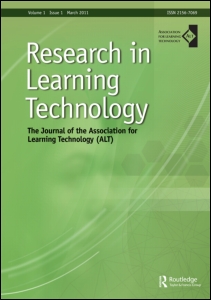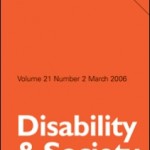#4 ‘Disability, Technology and e-Learning’ edited by Jane Seale

So far this month, I’ve introduced three influential research papers from Disability and Society to highlight academic research that is free to all readers this month as part of Routledge’s Education Free For All event. Today, we divert to a new journal – Research in Learning Technology. [update: 5th Jan 2011] Research in Learning Technology is now Open Access and all back issues are available. Research in Learning Technology is the journal of the Association for Learning Technology (ALT) previously entitled ALT-J, and more specifically, I’d like to highlight a special issue of the journal devoted to accessibility and edited by Jane Seale (Vol 14, Issue 1).
Nine papers and articles are included. As this issue is now five years old, many of the authors have substantially developed their positions as contexts and discourses in the field have developed. Nonetheless, many of these papers remain relevant to the field with implications for wider uses of technology, and I recommend this issue as a Who’s Who of significant authors in Accessibility in e-Learning. In the UK and elsewhere, Universities frequently represent key sites of cutting edge accessibility research. As such, this offers an excellent spring board into more recent accessibility literature across the education journals freely available this month – so flex your search operators!
- Disability, technology and e-learning: challenging conceptions, by Jane Seale.
- An exploration of the potential of Automatic Speech Recognition to assist and enable receptive communication in higher education, by Mike Wald.
- Creative solutions to making the technology work: three case studies of dyslexic writer in higher education, by Geraldine Price.
- Using multimedia to enhance the accessibility of the learning environment for disabled students: reflections from the Skills for Access Project, by David Sloan, John Stratford and Peter Gregor.
- A model for the identification of challenges to blended learning, by EA Draffan and Peter Rainger.
- Holistic approaches to e-learning accessibility, by Lawrie Phipps and Brian Kelly.
- The development of accessibility indivators for distance learning programs, by Sheryl Burgstahler
- Making online learning accessible to disabled students: an institutional case study, by Martyn Cooper.
- Accessibility and adaptability of learning objects: responding to metadata, learning patterns and profiles of needs and preferences, by Steve Green, Ray Jones, Elaine Pearson and Stavroula Gkatzidou.
Note: Many of these authors are on Twitter (for example, @briankelly @sloandr @lawrie @EADraffan @janeseale and others). Be sure to seek them out. If you are accessing this blog post after Routledge’s Open Access period finishes. In addition, many of the authors above have also published freely available research elsewhere. For example, Brian Kelly’s stellar back catalogue can be found at UK Web Focus. Enjoy!



